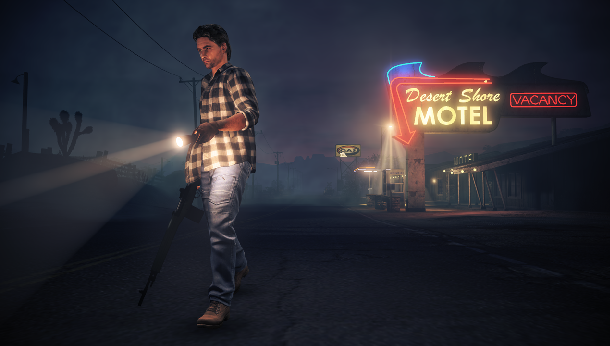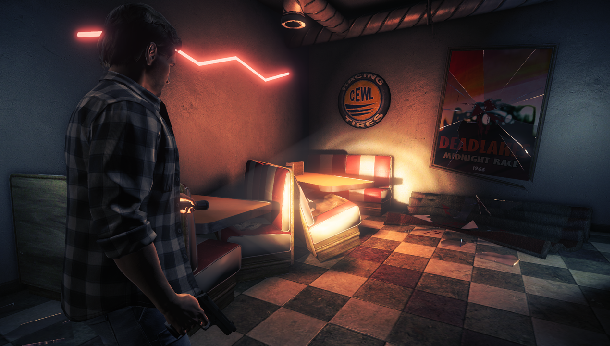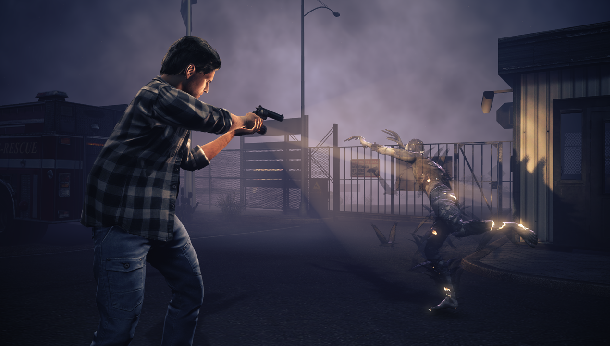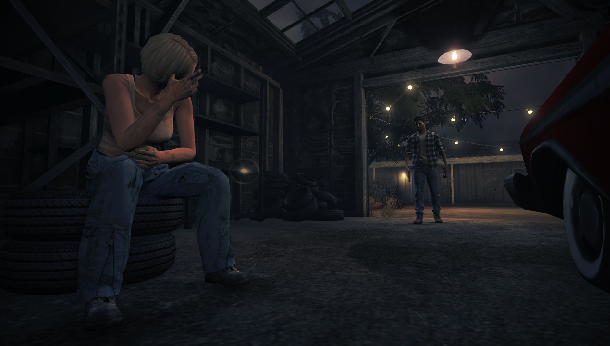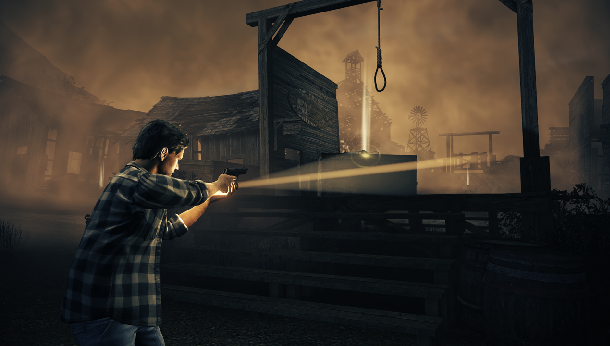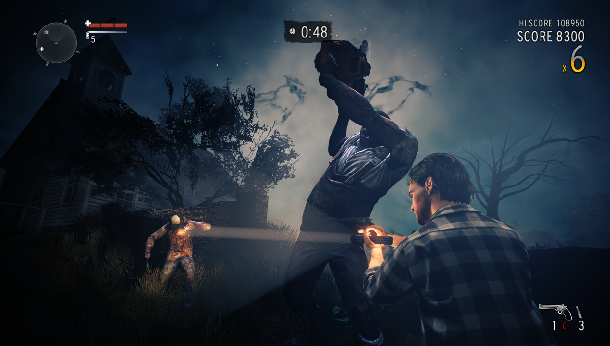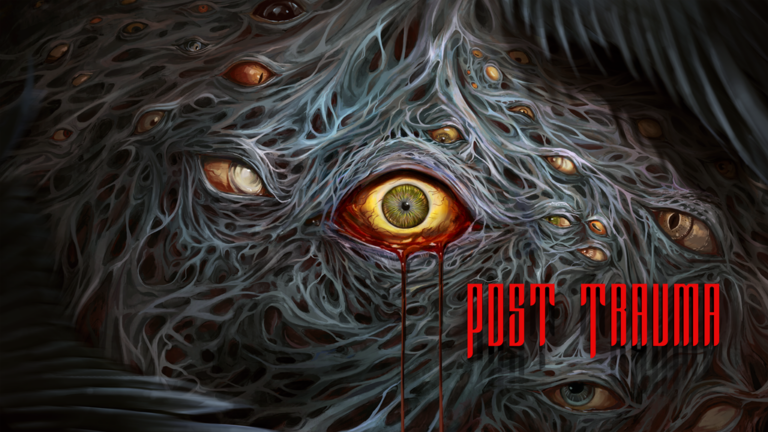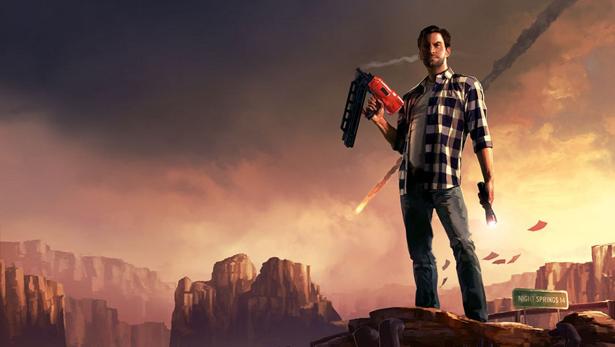
Alan Wake’s American Nightmare is the spiritual sequel to the psychological-thriller video game, Alan Wake. I say “spiritual” because even though Alan Wake’s American Nightmare takes place two years after the events of Alan Wake and is definitely canon, it’s more of a stand-alone entry that beginners and veterans alike can get into as opposed to a proper sequel. If the original game was Season 1 of Alan Wake, this would be something like a direct-to-DVD movie. Alan Wake has returned, this time to Xbox Live Arcade, so how does his new story stand among its competition?
Note: This review contains spoilers for the original Alan Wake.
The game follows our title protagonist, Alan Wake, as he experiences a nightmare in Night Springs, Arizona. Night Springs is the name of a Twilight Zone-esque television series that appeared in the original game, titled after the fictional town the show is set in. Alan doesn’t remember the specifics of his situation, but he has found himself in an episode of Night Springs he himself wrote titled “Return.” Stuck somewhere between reality and fiction, he is also met with his most devious foe yet, Mr. Scratch; a demented otherworldly serial killer that has taken on the ‘role’ of being Alan, both in appearance and name. Scratch is on a trip across America, murdering unlucky people that cross his path just for kicks with an almost child-like glee. Wake now has to find a way to stop Mr. Scratch before his life is taken over and ruined by his evil doppelganger.
The story is actually rather simple though with a few unexpected twists, split into three ‘Acts’. The real meat comes from its characters and dialogue. Mr. Scratch is an enjoyable villain who is just as demented as he is child-like, while Wake himself acts as something like a straight-man who is both calm and sarcastic through the game’s events. The rest of the cast are a group of females who fall into various horror archetypes, but are written and developed well enough to be likable despite their cliches. The story sometimes gets a bit cheesy as well, but it works with the game’s late-night television feel, flowing well with the Night Springs narrator occasionally explaining the situation over-dramatically. The story unfortunately is a lot weaker than the original Alan Wake overall, missing the sense of mystery and build-up the original game had. Avoiding spoilers, the ending also is a bit disappointing though I found I couldn’t help but smile at it. Overall while the story lacks some punches and is a tad bit disappointing, it did manage to keep me engrossed and make me laugh on several occasions.
The game also has some pretty cool optional story scattered around the stages. The manuscript pages have to be commended as the quality of writing in them has improved greatly from the first game. They often are now much more cryptic as to not spell out what’s about to happen to you–that is when they actually pertain to what is about to happen rather than what’s happened. The manuscript pages often cover what has happened rather than what’s happening to help ease new players into the game’s story and flesh out some of the characters’ pasts. While a good chunk of the manuscript pages tackle things veterans will already know, there’s enough new content about the characters here to keep things interesting. The other forms of optional story come audibly from radios and visually from televisions. The radio stations amusingly are an antithesis to the original game’s with a radio host that isn’t nearly as smooth as he would like to be. Televisions depict Mr. Scratch’s demented killings and messages to Wake. The game never takes itself that seriously and sometimes even takes jabs at itself, but it’s all entertaining.
The game still has the same basic approach to gameplay and combat–You possess a flashlight and a gun and you must face possessed Taken by using light to weaken away their Darkness shields which leaves them vulnerable so you can shoot them dead. However, the game changes more of its core mechanics than one might expect. The first thing I noticed was that you can no longer ‘shimmer’ enemies, by which I mean that your flashlight doesn’t affect enemies unless you make the beam stronger. In the original Wake, even when you weren’t focusing your beam and letting the battery recharge, the light from your flashlight could still ‘shimmer’ enemies’ darkness shields and make them weaker, just at a considerably slower rate. In this game, your flashlight won’t hurt enemies shields unless you’re aiming your beam down at them. To help make up for this, your flashlight recharges much faster now, but it won’t start recharging until after you haven’t been using your flashlights beam for a few seconds. Wake’s health no longer automatically regenerates either, if your health gets down to a certain level you can only heal by finding and getting under a light post.
I found that flare guns and flash grenades weren’t nearly as powerful as they used to be. They can still one-hit kill enemies, but only with a direct hit; surrounding enemies in the blast radius won’t be killed but simply have their darkness shields removed or become stunned. Alan is also a bit faster now and can run for much longer periods than in the first game (about four times as long). He can outrun enemies a lot easier, but the Taken themselves have become much craftier. Some throw grenades of Darkness from stunningly long distances, some can come charging at you if you distance yourself, and some even can turn into a flock of birds and reform around you for a surprise attack. Small twists to the formula like this actually make a big difference, and the number of small changes combine together to make the combat feel a lot more strategic.
There’s also many more guns this time around, which are handled and balanced excellently. Guns are unlocked by collecting Manuscript pages, which unlock briefcases holding new types of weapons when you obtain a certain number (they are also unlocked for Fight Till Dawn mode, an arcade-style arena fighting mode). The guns are varied in how they feel and players should be able to find a combination of main and secondary firearms they like to carry around with them (you are able to carry one smaller gun, and one larger one, as well as a flare gun and flares and flash grenades). Remedy have also tackled a complaint from the first game and guns and ammo now carry over between stages instead of them magically being discarded between them.
The changes don’t just stop at the combat however. One big complaint of the original Alan Wake was that the game was too linear, and Remedy have (excuse the pun) remedied that. The stages now are less straight paths than they are big open fields you’re free to explore. This change of pace probably was the biggest surprise and joy in the game for me. There’s about a total of three of these ‘fields’, or hub stages. While you do go around them completing tasks, you also are free to explore, and there are quite a few different paths you can take to reach a certain destination. Want to go run out in the middle of the desert? You can do that. Rather stick to the highway? Go for it. Rather scale a mountain? That’s an option too. The hub style works really well for the title, and are of good size to be fun to explore but not large enough to get lost in. There is plenty to do in them and luckily doesn’t fall into the ‘sandbox trap’ of having large empty spaces of nothing.
There is one complaint I have with them though. In the first stage especially, there’s abrupt invisible walls. The other two stages don’t suffer from this as much, but you’ll find that eventually in your travels you may venture too far from the stage, signified by the wind suddenly picking up to something like a dust storm. Continue much further in the storm and you’ll run into an abrupt invisible wall. Invisible walls are never fun as they give the player a restrained feeling that also breaks immersion. It’s not in anyway game-breaking or frequent, but you feel there could of been a better way to define the edge of a stage more (the second and third stages tackle it much better overall, with long drops or cliffs/gates to signify the edge in most cases). You also travel to these three stages three different times each during the story. Though they add some twists each time to keep things interesting, it still would have been nice to see more of these stages rather than visit ‘remixed’ versions of the same locations.
The game also has expanded its dialogue options. In Alan Wake you’d have to wait around someone if you wanted to hear all the dialogue they had to say, and it never was quite certain when they were finished talking. In this game it makes it clear when their dialogue branches are up, and players who want to listen can press the B button to continue their conversation with the person to unfold more of the story, or skip it if they just want to get back into the game.
Presentation for the title is fantastic. The graphics have had an upgrade both technically and artistically and now are much more vibrant. There’s a lot of detail in all of the environments which help make each place feel like part of a coherent world. The Darkness takes on a more physical role in this title, and some cool murky-looking effects have been added which makes Taken and physical Darkness almost look they’re shrouded in murky dark water that pulsates around the screen. Players who complained that the original game was sub-HD will also not have an issue with American Nightmare, as the resolution is much higher now.
The atmosphere is also caught fantastically with the game’s musical score. Like the original, American Nightmare uses music fantastically, though in a style that’s very different than the original Alan Wake. The music is somewhat more low-key but mood-capturing. Some of it even captures an Akira Yamaoka (Silent Hill sound director up until Shattered Memories) vibe, which I say as a compliment. The game also makes use of licensed music and specially composed vocal songs for the game fantastically for a few cool set-pieces. The music may not be as ‘beautiful’ as the first game, but it definitely is much more ‘mood-capturing.’
For features, it seems some things have been added and some have been taken away. When I beat American Nightmare I was excited to go through it again on a harder difficulty, but was disappointed to find that, in the story mode at least, there is only one difficulty. While the difficulty isn’t too easy or too hard, it would have been nice to have been able to amp up the story’s difficulty for more of a challenge. The game has a nice collectibles screen which offers some amusing descriptions for the guns you’ve unlocked, as well as a place where you can re-listen to radios, watch cutscenes, or read manuscript pages that you’ve collected. The game’s options have also been expanded to be much more in-depth. You can now do things like turn the HUD off or fading, or change the controller layout or game audio levels in much more detail. There’s a downloadable content option on the main menu, but at the point and time this review was written, it’s not entirely certain what DLC they have planned for the game. And then there’s Fight Till Dawn Arcade Mode, which is a whole other beast in itself.
Fight Till Dawn is the game’s arcade mode, a wave-based arena survival game where the goal is to get the highest score before time runs out. You start off with a single map, but there’s a total of 5 maps to go through, and each map has a ‘Nightmare Difficulty’ version of it which you can also unlock. Maps are unlocked by achieving ‘Stars’, which you obtain by reaching a certain score in a stage, with a total of three stars to earn in each map. This might be the biggest departure from the original Alan Wake one might imagine, but it surprisingly works and is quite fun. The five arenas are completely new and don’t appear in the game’s story mode (though you can see a few of the maps in the distance during the campaign) which almost makes this feel like another half to the game. Each map has an amusing cheesy description and each match starts with an equally cheesy line by the Night Springs narrator.
This mode I found to be quite a bit more challenging than the game’s story mode. There’s an increased focus on survival, but also on doing well in matches. Your best score gets recorded on an online leaderboard for incentive to improve or get a better score than your friends. There are a few key ways to do a bit better in this mode though (at the time of writing I’m topping nearly every leaderboard compared to the other reviewers. Come on, other reviewers, pick up your game!).
Firstly, sometimes it’s best to wait to kill an enemy rather than kill them straight-on. The game has a Score Multiplier, which decreases over time signified by how much “Color” the number of the multiplier is filled up by (the Score Multiplier fills with color from the bottom to the top as you do well in the game. When it completely fills to the top, the multiplier goes up by one, with a cap of x9.). Killing enemies does fill the gauge, but it’s filled almost twice as much for successful dodge maneuvers. Now, of course, you don’t get points until you’ve killed an enemy, but sometimes it’s a good idea to be more defensive and raise your Score Multiplier and then take on the offense when it’s high rather than to simply kill everything in sight. This makes for an interesting cat-mouse scenario when trying to go for high scores, especially since a single hit will knock your multiplier back to one (and it drains over time as well). Also, it’s a good idea in the last 30 seconds or so to clear the map of every enemy and let the next enemy wave begin, as if you survive till dawn the sun breaks and every enemy on the arena currently is killed and added to your final score.
The arenas themselves are interestingly designed and of good size to be explorable and allow for different environmental strategies for players. Weapons and items are scattered around, including weapon briefcases which are unlocked when you collect a certain number of Manuscript pages in the game’s story mode.
While this may be a straight up Horde mode, the twists and gameplay mechanics of American Nightmare’s Fight Till Dawn mode make it a pretty tense experience and turns out to be a lot of fun to play, and the Nightmare difficulty maps are appreciated for those who want even more of a challenge. However, it’s a bit disappointing that such a mode doesn’t have any form of multiplayer. Not to say every game needs online, but it’s hard to shake the feeling of how much fun a mode like this would be with a friend.
So what did I think of Alan Wake’s American Nightmare? Bluntly, I was both extremely impressed and somewhat disappointed. It seems Remedy have gone out of their way to fix about every issue people had with the original game. In the process, though, it’s strange to see that some things that the first game did excellently are now absent or lackluster here, and a couple of new issues have popped up. The story is a tad bit too simple for its own good and the game doesn’t have nearly as strong of an atmosphere as the first game had. This probably is because Remedy had different goals for American Nightmare, but these elements are missed as they are a big part of the appeal of Alan Wake. The game also makes you repeat environments three times each through the story mode. While Remedy handles it better than most other games with similar design choices, you can’t help but feel this was done to extend playtime. The game does have an explanation as to why you’re reliving through the same environments and key gameplay moments, but it feels more like an excuse than a validation. Later in the game things start to feel a bit repetitive, but Remedy do throw in some cool set-pieces to keep things fresh and the game finishes before it overstays its welcome.
This might sound overly negative, but it’s only because I loved American Nightmare and it definitely accomplishes its goal of being a fantastic XBLA game. It is both accessible to new players and a fantastic addition for veterans. But because the focus of being an XBLA title, it feels like Remedy held itself back a bit too much from making a grand story to something much more simple, with the focus this time clearly being set on more fun set-piece moments rather than atmosphere. The game also does an excellent job at building up Mr. Scratch and hints about future dark forces we may see in upcoming Alan Wake installments, but the ending that it built up to was pretty disappointing. I don’t want to spoil anything, but I will say there’s nothing in the form of final boss encounters–or any bosses at all, which would of been interesting to see with the game’s more sci-fi and action focus here.
Alan Wake’s American Nightmare is both an excellent installment to the series and the platform’s XBLA line-up in general. While in direct comparison to the original game you may find a few disappointments here and there, the game delivers in excellently designed hub-like stages, improved combat that is more strategic and varied than it’s ever been, and delves in quite a few cool and exciting moments that will put players on edge. There was more than one moment in the game that I just took in what was happening and thought to myself, “Wow, this is cool!” Something not many games accomplish. With a 4-7 hour long campaign, along with the fun and tense Fight Till Dawn mode, the game offers plenty of bang for your buck. Accessible to newcomers and plenty of gameplay twists for existing fans, it may not be the sequel that many were hoping for, but it is a fun stand-alone experience that is definitely worth checking out.
 (8.5 / 10)
(8.5 / 10)
Great
 (8.5 / 10)
(8.5 / 10)
